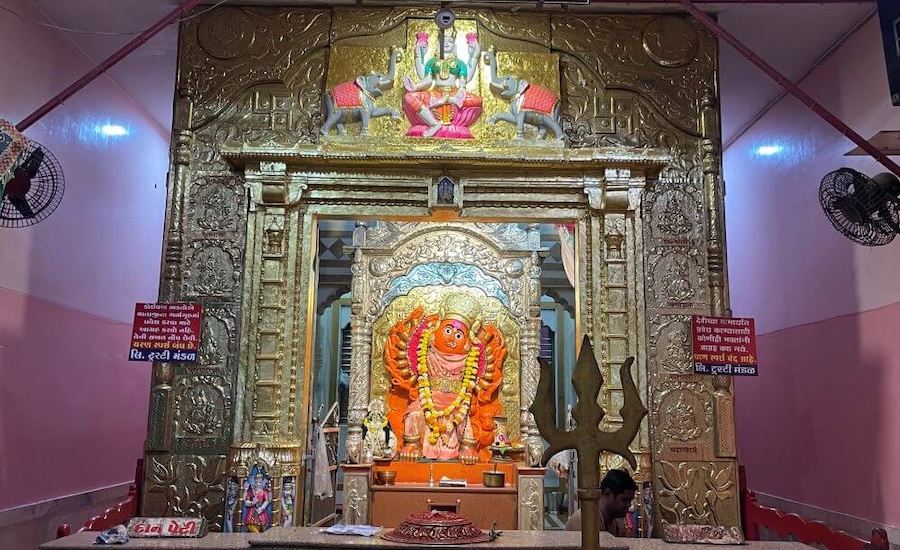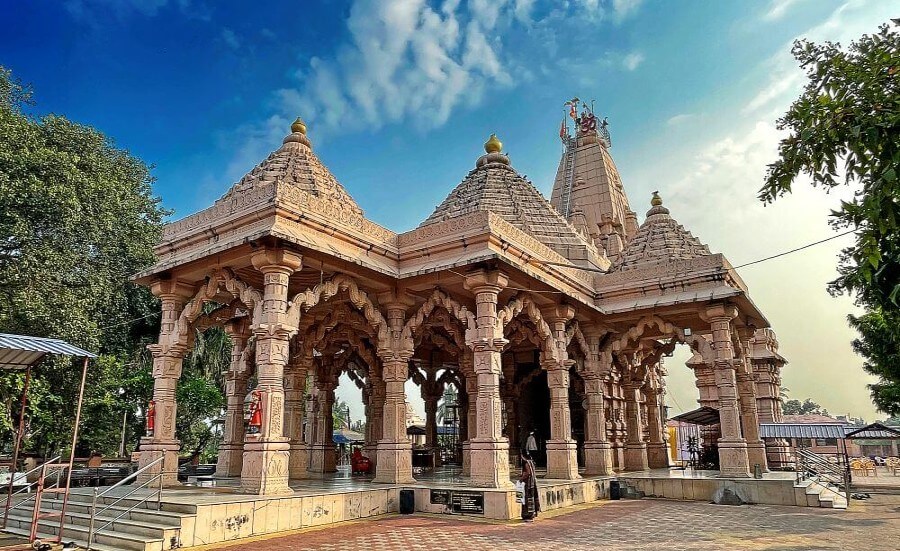
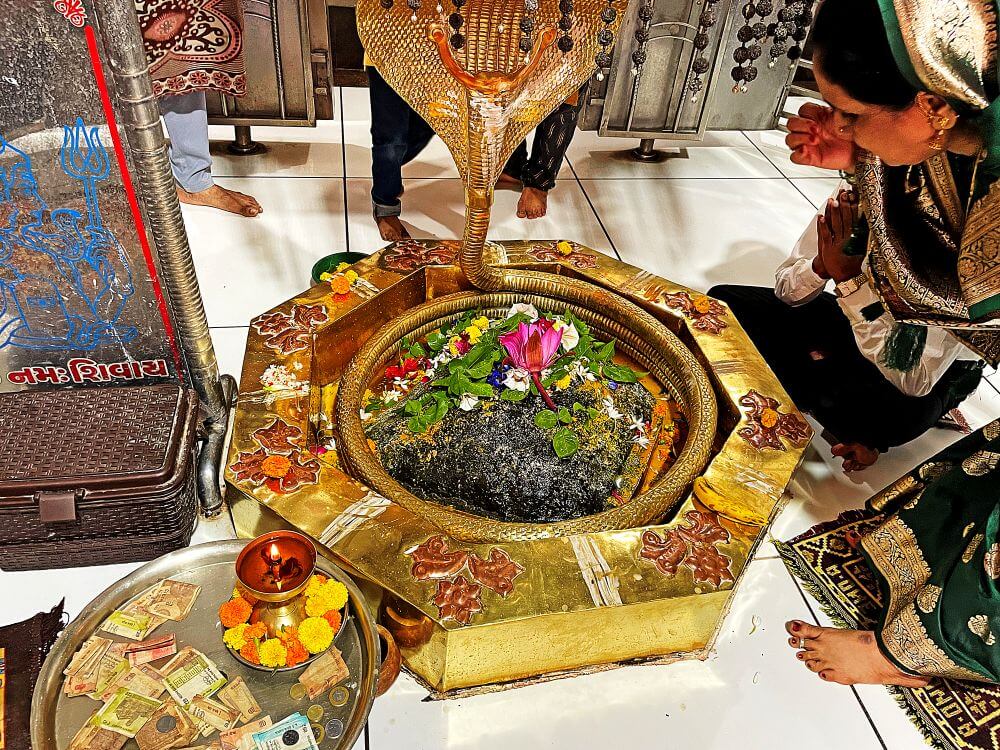 One of the ancient Shiva temples in Gujarat, the Kedareshwar Mahadev Temple is located in Khali village near Bardoli. With a history spanning over 700 years, this sacred temple is situated on the banks of the Mindhola River. Devotees believe the Swayambhu Shiva Lingam (self-manifested representation of Lord Shiva) enshrined here is imbued with divine presence. It is said that Chhatrapati Shivaji Maharaj visited this temple during his campaigns in Surat to seek Lord Shiva’s blessings. A statue of Mahatma Gandhi has also been installed in the temple’s vicinity to commemorate the immersion of his ashes in Bardoli.
One of the ancient Shiva temples in Gujarat, the Kedareshwar Mahadev Temple is located in Khali village near Bardoli. With a history spanning over 700 years, this sacred temple is situated on the banks of the Mindhola River. Devotees believe the Swayambhu Shiva Lingam (self-manifested representation of Lord Shiva) enshrined here is imbued with divine presence. It is said that Chhatrapati Shivaji Maharaj visited this temple during his campaigns in Surat to seek Lord Shiva’s blessings. A statue of Mahatma Gandhi has also been installed in the temple’s vicinity to commemorate the immersion of his ashes in Bardoli.
According to local lore, around 600 years ago, this area was a dense forest. Shepherds from nearby villages often brought their cattle to graze there. One day, a cow was seen releasing her milk on a particular stone in the forest. 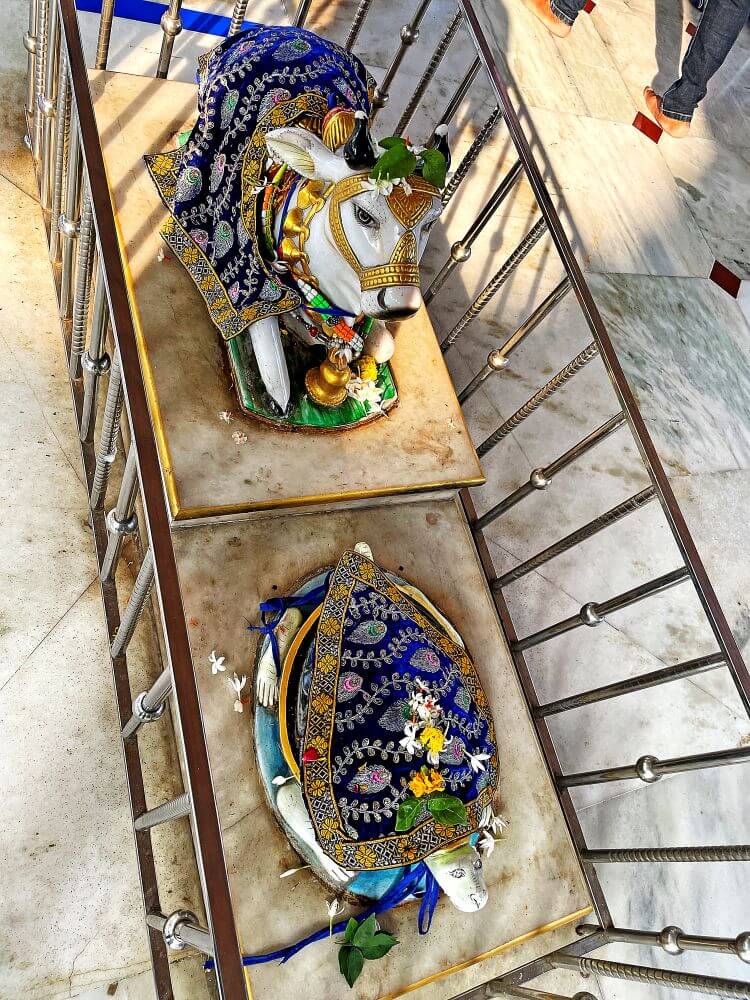 This continued for days, puzzling the cowherd. Lord Shiva is said to have appeared to the cowherd in a vision, directing him to excavate the spot where the cow offered milk. Upon digging, villagers discovered a Shiva Lingam. Seven treasure chests were reportedly found alongside. The villagers built a small temple, which has been expanded and renovated over the centuries, culminating in its grand form after a major restoration in 2001.
This continued for days, puzzling the cowherd. Lord Shiva is said to have appeared to the cowherd in a vision, directing him to excavate the spot where the cow offered milk. Upon digging, villagers discovered a Shiva Lingam. Seven treasure chests were reportedly found alongside. The villagers built a small temple, which has been expanded and renovated over the centuries, culminating in its grand form after a major restoration in 2001.
It is believed that in 1664, during his campaign in Surat, Chhatrapati Shivaji Maharaj visited the Kedareshwar Temple. He performed a solemn ritual and hoisted a saffron flag atop the temple’s spire, seeking blessings for his mission. Another fascinating historical note links the temple to the Chinese traveller Xuanzang (Hiuen Tsang), who visited India between 630 and 641 CE. According to information displayed at the temple, Xuanzang mentioned the Kedareshwar Temple in his travel chronicles while describing the temples he encountered during his journey through Gujarat.
Located just 4 km from Bardoli, the temple greets visitors with an impressive gateway adorned with intricate carvings. At the top of the gate is a meditative statue of Lord Shiva. Inside, the temple complex features a paved courtyard, a 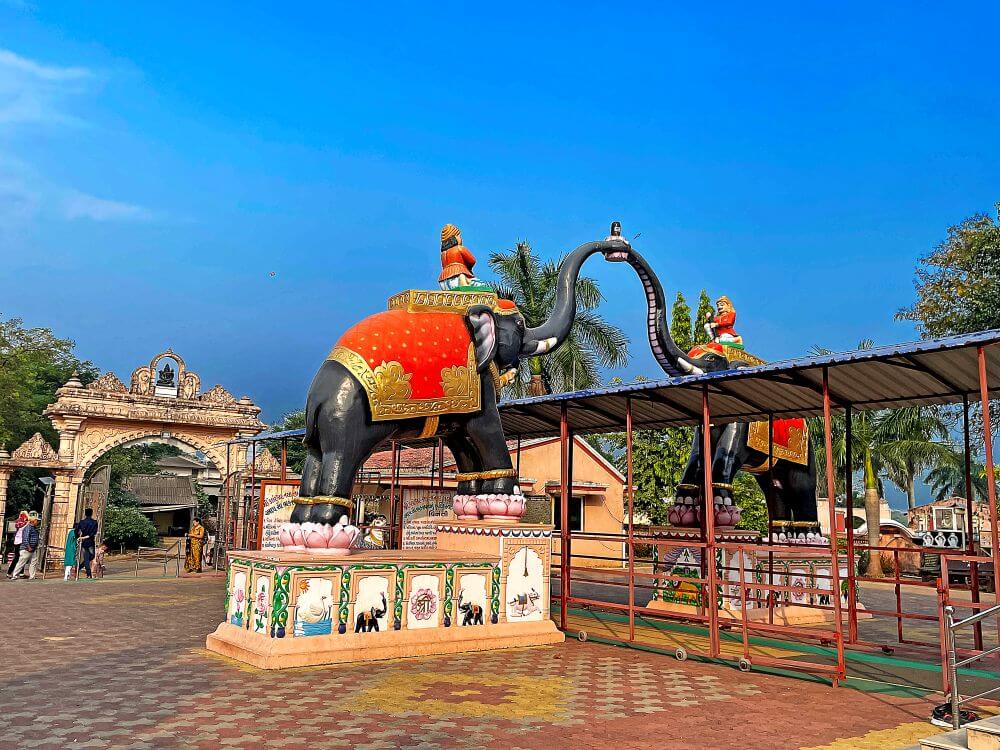 shallow tank for ritual foot-washing, and a red sandstone structure that exudes an aura of sanctity. A covered pathway provides shade to devotees as they proceed towards the temple.
shallow tank for ritual foot-washing, and a red sandstone structure that exudes an aura of sanctity. A covered pathway provides shade to devotees as they proceed towards the temple.  Along this path, a marble statue of Nandi (Shiva’s sacred bull) is enshrined, with a tortoise idol nearby. At the entrance to the assembly hall (Sabhamandapa), on either side, are grand statues of elephants with their trunks raised. A unique feature of these statues is the depiction of the elephants lifting a small Shiva Lingam together with their trunks.
Along this path, a marble statue of Nandi (Shiva’s sacred bull) is enshrined, with a tortoise idol nearby. At the entrance to the assembly hall (Sabhamandapa), on either side, are grand statues of elephants with their trunks raised. A unique feature of these statues is the depiction of the elephants lifting a small Shiva Lingam together with their trunks.
The Kedareshwar Temple is built on a high platform, showcasing its grandeur. The architectural layout of the temple includes a porch (Mukhamandapa), the assembly hall (Sabhamandapa), a small intermediate chamber (Antarala), and the sanctum (Garbhagriha). Flanking the assembly hall on the left and right are additional porches, enhancing the temple’s design. The spires of the temple follow the Urushringa style, which is a hallmark of many temples in Gujarat. This architectural form features a central tall spire accompanied by a cascading series of smaller spires leading downward. The temple is adorned with pyramid-shaped spires over the Mukhamandapa and Sabhamandapa, while the sanctum boasts a grand, towering spire, further elevating the temple’s majestic appearance.
The stone columns are intricately carved with floral and geometric designs, and between them are beautiful Makara Toranas (ornamental arches). Statues of guardians in traditional Kathiawadi attire flank the temple’s entrance. The open design of the Mukhamandapa and Sabhamandapa allows for ventilation and natural light. The Mukhamandapa’s entrance columns feature statues of gatekeepers dressed in traditional Kathiawari attire, adding a unique regional touch.
In the Sabhamandapa, there also is a marble pedestal that enshrines statues of Nandi (the sacred bull of Lord Shiva) and Kurma (a tortoise, representing Vishnu’s second incarnation). From the assembly hall, three steps lead 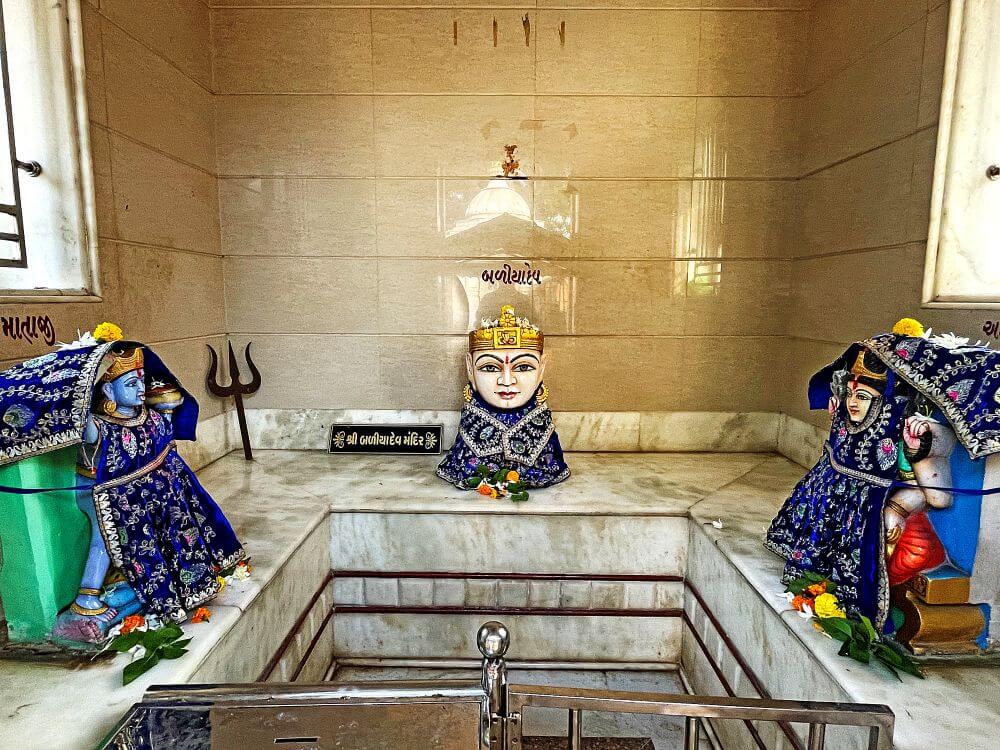 downward into the intermediate chamber (Antarala). Within this chamber, intricately designed niches covered with golden-plated panels house statues of Hanuman on the left and Ganesha on the right. The pillars of Hanuman’s niche are adorned with carvings of monkey devotees in various postures, while the pillars of Ganesha’s niche feature intricately sculpted images of mice, Ganesha’s sacred vehicle.
downward into the intermediate chamber (Antarala). Within this chamber, intricately designed niches covered with golden-plated panels house statues of Hanuman on the left and Ganesha on the right. The pillars of Hanuman’s niche are adorned with carvings of monkey devotees in various postures, while the pillars of Ganesha’s niche feature intricately sculpted images of mice, Ganesha’s sacred vehicle.
The entrance to the Garbhagriha is equally resplendent, with golden-plated panels featuring elaborate carvings of foliage, flowers, and creepers. The doorframe is flanked by marble statues of Shiva’s gatekeepers (Shivadwarapalas). On either side of the frame are statues of attendants holding fly 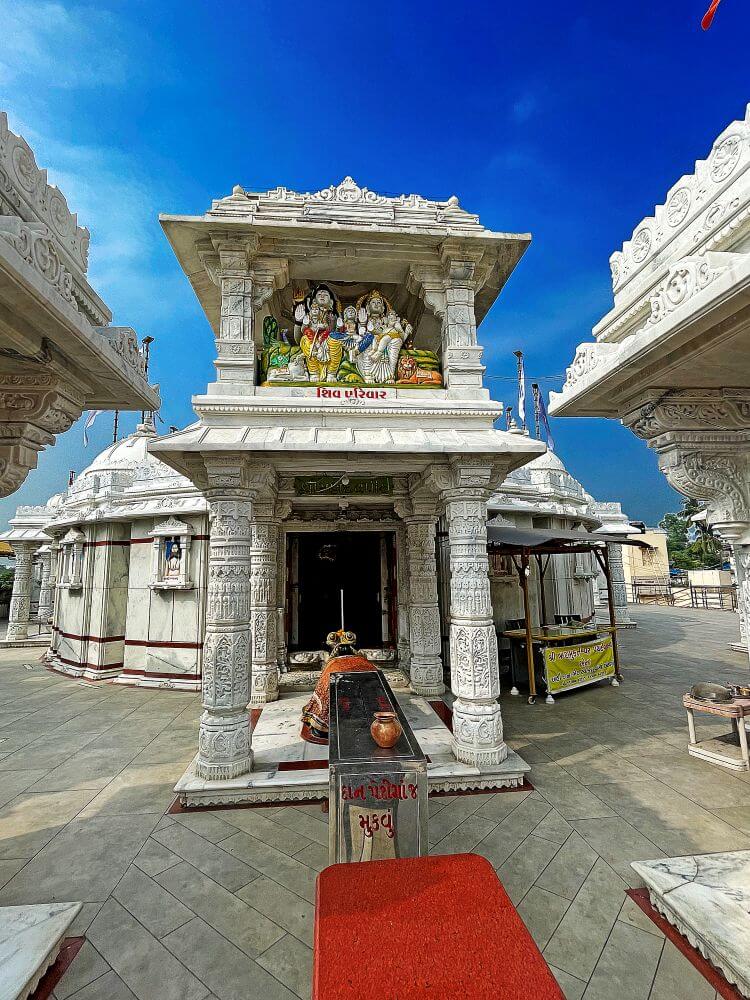 whisks (chamaras) and lion sculptures.
whisks (chamaras) and lion sculptures.
Above the lintel is a carved image of Ganesha, symbolically guarding the entrance. Above the lintel is a depiction of Lord Shiva seated on a tiger skin, accompanied by his celestial aides. The doorframe pillars near the Garbhagriha feature twelve square niches, each enshrining one of the twelve Jyotirlingas, representing Lord Shiva’s most sacred manifestations. At the very top of the doorframe, there is a Shiva Lingam dedicated to Pashupatinath, alongside another Lingam resembling the towering peak of Mount Kailash, symbolising Kailaspati Mahadev. These intricate placements reflect the temple’s deep spiritual significance and artistic brilliance, connecting devotees to the divine forms of Lord Shiva. At the heart of the sanctum lies the Swayambhu Shiva Lingam, crowned by a silver canopy and protected by a coiled serpent. A golden pitcher (Galantika) suspended above continuously drips water onto the Linga, symbolising eternal devotion. A statue of Goddess Parvati is enshrined in a niche on the rear wall.
Outside the sanctum, niches depict various deities such as the Dashavatars (ten incarnations of Vishnu), Shiva, and Devi, adding to the temple’s rich iconography. The temple complex includes shrines dedicated to Hanuman, Baladev-Mahakali-Annapurna, Laxmi Narayan, Sai Baba and Ganesha. The temple premises also include a hall for cultural events. Notably, there is a memorial for Mahatma Gandhi, featuring his bust and sculptures of the “Three Wise Monkeys” symbolising the moral message: “See no evil, hear no evil, speak no evil.” Gandhi’s ashes were immersed in the Mindhola and Tapi rivers near Bardoli, and a memorial was erected here in 2010 to honour his legacy.
The Kedareshwar Temple is a vibrant centre of worship, drawing thousands of devotees daily. Rituals such as Laghu Rudra, Maha Rudra, and Shiv Aradhana are performed regularly. The temple hosts grand celebrations during Mahashivaratri, with special Maha Puja ceremonies attracting large crowds. Other festivals like Gokul Ashtami and Chaitra Purnima are also celebrated with enthusiasm.
